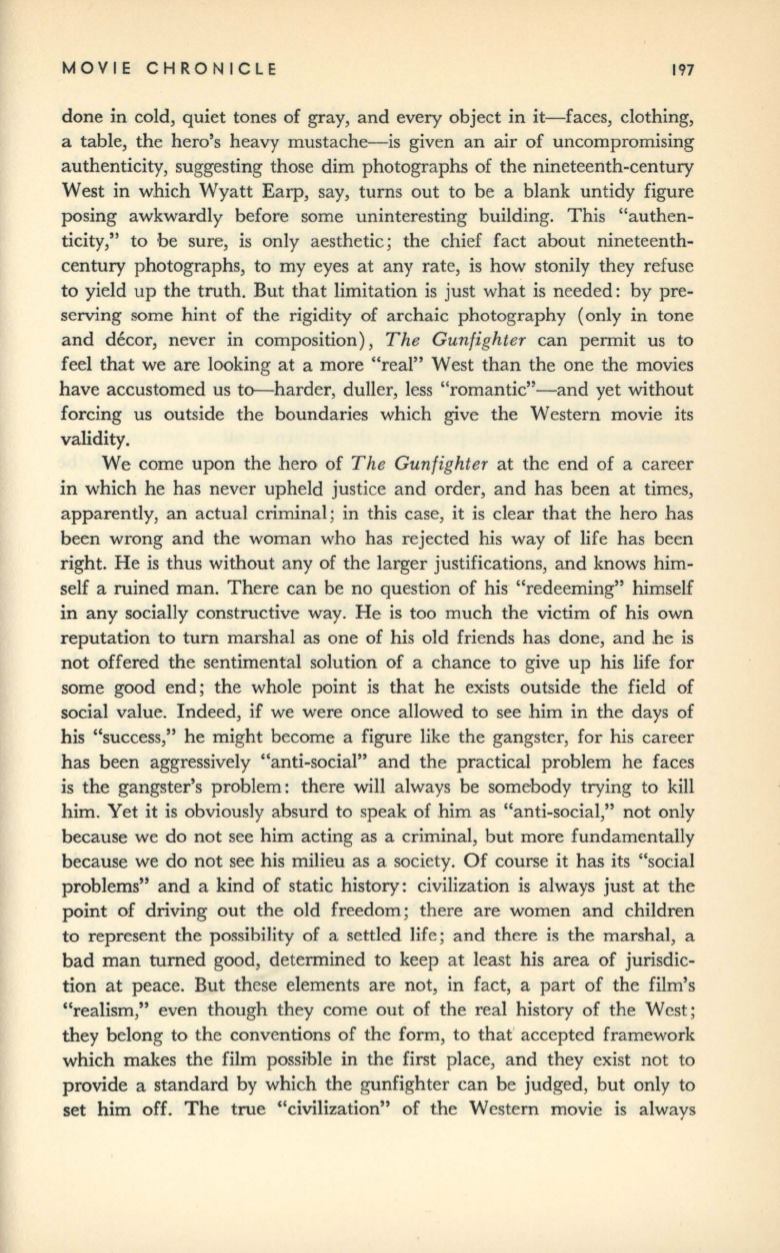
MOVIE CHRONICLE
197
done in cold, quiet tones of gray, and every object in it-faces, clothing,
a table, the hero's heavy mustache-is given an air of uncompromising
authenticity, suggesting those dim photographs of the nineteenth-century
West in which Wyatt Earp, say, turns out to be a blank untidy figure
posing awkwardly before some uninteresting building. This "authen–
ticity," to be sure, is only aesthetic; the chief fact about nineteenth–
century photographs, to my eyes at any rate, is how stonily they refuse
to yield up the truth. But that limitation is just what is needed: by pre–
serving some hint of the rigidity of archaic photography (only in tone
and decor, never in composition),
The Gunfighter
can permit us to
feel that we are looking at a more "real" West than the one the movies
have accustomed us to--harder, duller, less "romantic"-and yet without
forcing us outside the boundaries which give the Western movie its
validity.
We come upon the hero of
The Gunfighter
at the end of a career
in which he has never upheld justice and order, and has been at times,
apparently, an actual criminal ; in this case, it is clear that the hero has
been wrong and the woman who has rejected his way of life has been
right. He is thus without any of the larger justifications, and knows him–
self a ruined man. There can be no question of his "redeeming" himself
in any socially constructive way. He is too much the victim of his own
reputation to turn marshal as one of his old friends has done, and he is
not offered the sentimental solution of a chance to give up his life for
some good end; the whole point is that he exists outside the field of
social value. Indeed, if we were once allowed to see him in the days of
his "success," he might become a figure like the gangster, for his career
has been aggressively "anti-social" and the practical problem he faces
is the gangster's problem: there will always be somebody trying to kill
him. Yet it is obviously absurd to speak of him as "anti-social," not only
because we do not see him acting as a criminal, but more fundamentally
because we do not see his milieu as a society. Of course it has its "social
problems" and a kind of static history: civilization is always just at the
point of driving out the old freedom; there are women and children
to represent the possibility of a settled life; and there is the marshal, a
bad man turned good, determined to keep at least his area of jurisdic–
tion at peace. But these elements are not, in fact, a part of the film's
"realism," even though they come out of the real history of the Wcst;
they belong to the conventions of the form, to that accepted framework
which makes the film possible in the first place, and they exist not to
provide a standard by which the gunfighter can be judged, but only to
set him off. The true "civilization" of the Western movie is always


